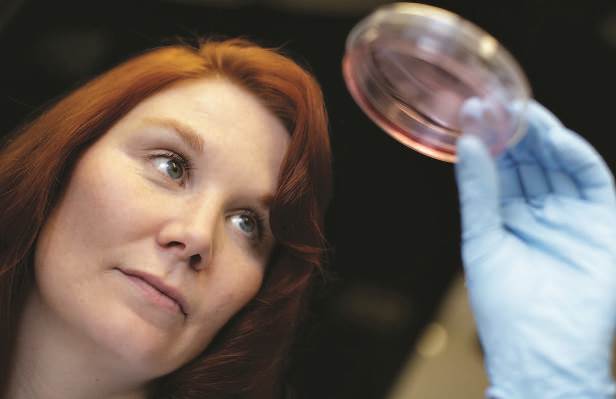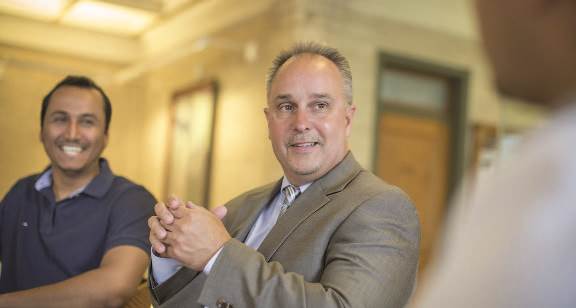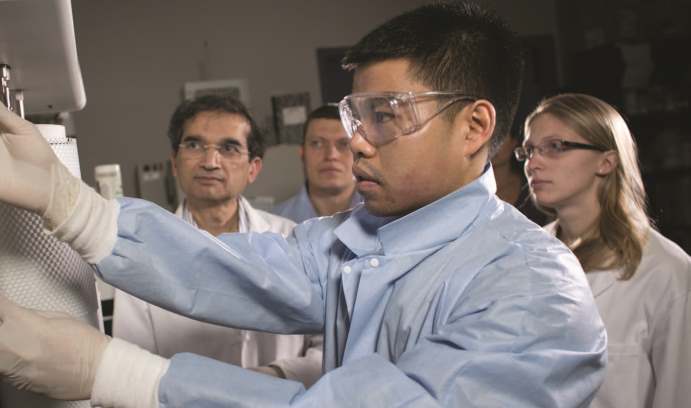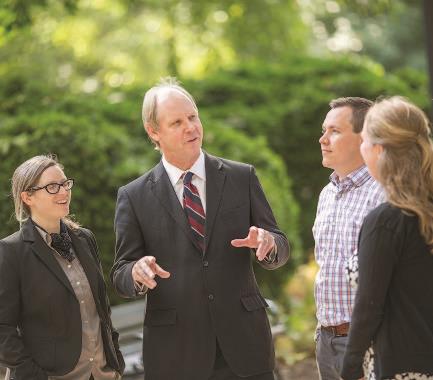A win-win-win situation
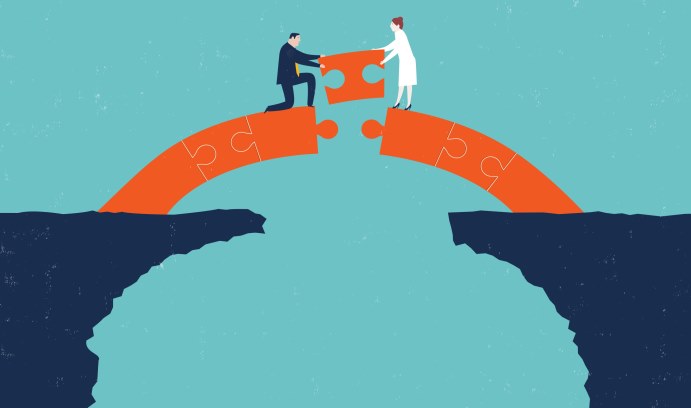
Six Lehigh research teams have completed the NSF I-Corps program, and four more are taking part in 2016. The goal of I-Corps is to help researchers commercialize the technologies they invent. (Illustration courtesy of Shutterstock and Linda Gipson)
Most researchers hope their insights and innovations will make the world a better place. In practical terms, that often means finding a market. But it’s easy to become enamored with hard-won discoveries without understanding their real value to others.
“The attitude often is, ‘I just invented this cool thing and I don’t know what it’s for but I’m sure 3 million people want to buy it,’” says John Coulter, professor of mechanical engineering and mechanics and interim dean of the P.C. Rossin College of Engineering and Applied Science.
To ground such thinking more firmly and specifically in real-world needs and opportunities, Lehigh has joined forces with the National Science Foundation (NSF) and research institutions across the country to embrace a new kind of innovative thinking—not about technology but the marketplace. Working through Lehigh’s Office of Technology Transfer, the university has become a leading participant in an NSF program called Innovation Corps, or I-Corps.
I-Corps’ goal is to foster entrepreneurship that will help commercialize the technology that NSF-funded research has supported. The program centers on an intensive seven-week training experience for a team of three people.
Each team contains a principal investigator who has led research into a commercially viable innovation and an entrepreneurial lead—often a postdoc or graduate student—whose daunting task is to identify a market need for the innovation, to develop insights into customers who might pay to use it, and to build a business model and potentially launch a start-up company. The third team member is a business mentor who helps find customers and who understands market realities and guides business planning.
I-Corps requires participants to conduct personal interviews—often in face-to-face meetings—with 100 different customers who can provide insight into the marketplace.
“Customers can be end users, manufacturers, suppliers, distributors, small businesses or research institutions,” says Yatin Karpe, associate director of the Office of Technology Transfer.
The needs of these customers, and their perceptions, shape the business vision—and often redirect the research that is being done in the lab, says Coulter.
“You need to have an awareness of what problem you’re solving and for whom. People don’t walk into your office and tell you what they need. You have to go ask them.”
In 2014, the National Alliance of Inventors ranked Lehigh fifth among American colleges and universities in I-Corps participation. A year later, six Lehigh teams had completed the program, with four more expected to take part in 2016.
“That’s an extremely high level of participation,” says Karpe, “especially given that we’re a small school next to universities whose research expenditures are measured in the hundreds of millions of dollars.”
Lehigh has long had a reputation for producing innovators “who can hit the ground running and get things done effectively,” Coulter says. “We’re very proud of that.” Yet entrepreneurship—the process of perceiving new business opportunities and building commercial enterprises around them—has not been emphasized in the past.
“Our core mission is teaching, research and service,” Karpe says. “Encouraging entrepreneurial activity is like adding a fourth leg to that stool.”
The pivotal moment
Researchers stepping for the first time into the hurly-burly marketplace can face culture shock.
“It’s very humbling,” says Sabrina Jedlicka, assistant professor of materials science and engineering and a faculty member in Lehigh’s bioengineering program. “I was put in my place very quickly.”
After an intended entrepreneurial lead left the project to take a job, Jedlicka stepped into that role on a project with Coulter pertaining to mechanotransduction, the process by which cells translate mechanical stimuli into biochemical activity.
“I-Corps trainers didn’t care about our research or understand what we were doing,” Jedlicka says. “They just wanted us to tell them what the market was.” With limited experience in industry, she adds, “I was shocked and appalled that none of what John and I had done mattered unless we could find customers for it. That was the first hour of Day One.”
But the conversations that Jedlicka and Coulter had with customers proved revealing.
“We pivoted to a market we hadn’t envisioned,” Coulter says. Their innovation was to use injection molding to create nanostructured polystyrene consumables for the biomedical industry. To potential customers, that sounded like “bumpy petri dishes.”
“It sounds like the least sexy thing in the world,” Jedlicka says. “But many cells respond to mechanical input so that their behavior in vitro changes depending on the properties of the surface they grow on. So knowing that, why not make petri dishes specialized instead of a dime a dozen?”
As they listened to the people they interviewed, the team turned toward the in vitro fertilization market.
“Cell division on our bumpy surfaces is more consistent,” Jedlicka says. “If you can improve cell division when you grow embryos, you significantly change a limiting factor. That’s a natural and very human market.” The team also sees potential applications for drug testing, academic research, and tissue engineering. “We’re looking to disrupt the petri dish industry,” Jedlicka says.
Such experiences are common. I-Corps calls them pivot moments—times of “aha” understanding that can change the direction of a project.
An unexpected revelation
Chao Zhou had his eyes opened when undergoing an optical coherence tomography (OCT) scan during one of his customer interviews. Zhou, assistant professor of electrical and computer engineering, and his group were exploring the market for a faster form of OCT—widely used in ophthalmology to produce 3D diagnostic images of the eye.
Using a method called space-division multiplexing, Zhou’s group had developed a process that splits a beam of infrared light into 16 different beams and creates nanosecond delays to encode the signals into different frequencies. The technique allows eye scans to be done 10 times faster than is possible using current technology.
“We learned that people in a doctor’s office don’t say they care about speed,” Zhou says. “They care about image quality and patient comfort.” Undergoing an eye scan—which can take up to 10 seconds using current technology—made clear the challenges of obtaining clear images from squirming patients.
“When something doesn’t work in the lab, we can just repeat the scan,” Zhou says. “I took for granted that you could repeat scans and patients would be okay with it, but that’s not the case.”
This insight shifted Zhou’s business pitch from speed to quality and comfort—which speed happens to allow. The team’s field research revealed that the immediate market for the system isn’t the end user in a doctor’s office but manufacturers. It also highlighted the need for a chip-based device that could be retrofitted onto existing equipment.
“I-Corps helped us clarify our targets,” says Zhou, who subsequently applied for a second I-Corps session to hone the focus on manufacturers.
Martin Harmer, the Alcoa Foundation Professor of Materials Science and Engineering, experienced multiple pivots with his I-Corps training. His team’s innovation was a pre-treatment process for a ceramic powder of magnesium aluminum oxide. The treatment optimally combines temperature and pressure to remove impurities so that when a powder is fired, the resulting ceramic is transparent, with impressive ballistic protection capabilities—like bulletproof glass, only lighter.
“We thought it might be useful for windows in military vehicles like tanks and Humvees, where saving weight is important,” says Harmer.
After digging into the market, however, Harmer’s team gained a valuable insight: It can often be difficult for a small start-up to build a sustainable business relying on the Department of Defense.
“It’s not a very steady market,” says entrepreneurial lead Animesh Kundu, a research scientist in the Center for Advanced Materials and Nanotechnology. “Demand for an item for, say, the Navy, might go from zero to $50 million, then back to zero. I didn’t realize the market was so volatile.”
The team also discovered that few companies in the world manufacture tank windows or deal with transparent ceramics, reducing options.
“There wasn’t one main obstacle,” Harmer says. “There were just many elements that we thought would be viable but were problematic.” The team pivoted away from armor and toward specialized niche markets in optics and optical sensors such as protective housings for drone cameras and lasers or guidance domes at the front of heat-seeking missiles.
“Smaller, high-cost, very value-added optoelectronic components are a better way to go,” Harmer says.
Asking the right questions
Mayuresh Kothare has learned that being enamored with an innovation can cloud one’s vision in the marketplace and in the lab unless one guards against bias.
Kothare’s team has investigated the market for a new kind of portable, battery-operated medical oxygen concentrator (MOC). Such devices have been a godsend to people suffering from chronic obstructive pulmonary disease (COPD) and other lung conditions that make breathing difficult. Instead of needing to be confined to beds and connected by breathing tubes to large machines filled with compressed oxygen, patients using MOCs that extract oxygen from ambient air can carry on their normal daily activities.
Kothare’s team offered a new MOC design that uses one instead of two adsorbent beds to capture nitrogen from air under high pressure, obtain high-purity oxygen and then release nitrogen under low pressure. The simplified design allows a unit to be smaller and lighter than existing MOCs while potentially producing greater volumes of oxygen.
Yet simply asking pulmonologists if they could use such a device wouldn’t be helpful. “Of course they’ll say yes,” Kothare says. “That doesn’t tell you anything because you’ve already biased the question in favor of the device.”
A better query, says Kothare, “is to ask, ‘What are your biggest challenges?’ The more you listen, the more likely you are to hear hidden things that wouldn’t be revealed with a biased question.”
Such an approach is often vital to simply getting in the door, much less finding out anything useful, says Himanshu Jain, the T.L. Diamond Distinguished Chair in Engineering and Applied Science. His team investigated the market for a biocompatible, biodegradable glass that is porous on both macro and nanoscales, making it highly conducive to cell growth and for use as a scaffold for regenerating bone.
“We’re not trying to sell anything,” Jain says. “That made things a lot easier with people who get all kinds of calls and emails. If you try to convince them how exciting your technology is rather than listen to their needs, they take you differently.”
Jain’s team discovered that the orthopedic market they had in mind is conservative and resistant to adopting innovations not proven through clinical trials and experience. The team pivoted to dental applications. “One dental customer said, ‘Really, this is the kind of thing we need,’” Jain says. “That boosted our excitement and faith in the usefulness of our material.”
I-Corps alumni see many advantages to participating. It can open the door to renewed funding from the NSF and other sources. Some say it has changed how they think, teach and write grants.
“We want to educate students to be better at entrepreneurship, and the best way to do that is to surround them with people who are involved with it,” Coulter says. “That enhances both education and faculty careers, and in some cases will lead to positive financial outcomes in the near term. It’s a win-win-win situation.”
Posted on:


